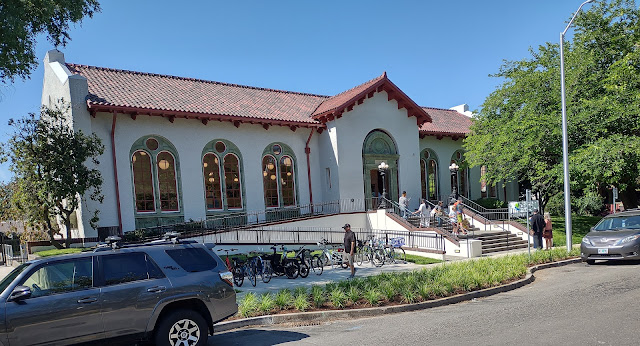There was, quite simply, nothing like it in Portland when Montgomery Ward & Co. opened its big new building NW 27th Avenue in 1920. By square footage, the nine-story edifice – with a 10th added on a bay on the western façade, was the largest edifice by square footage in Oregon. It also featured three railway spurs heading into the ground floor for delivering merchandise for retail and mail order sales.
While many commercial buildings of the era still featured historical architectural details of some sort, Montgomery Ward’s bold reinforced concrete construction celebrated its unadorned, muscular strength. As the largest structure in Portland and, supposedly, anywhere west of the Rocky Mountains, it was “the finest extant example of period reinforced concrete industrial architecture in the city,” according to a historic review.
 |
| Entering the atrium from the west |
“Our goal is pretty straightforward: to preserve the
character of the building while continuing to invest in improvements that
support a vibrant mix of tenants and activity,” said Lauren Tangvald Menashe’s property
manager. “Montgomery Park has such an
important place in the city’s history, and we definitely want to keep that
spirit alive. A lot of our recent work has been focused on freshening things
up. There have been upgrades to some of the common areas, general maintenance, and adding new
tenant amenities.”
The goal is to fill six stories with offices, and offer
space for retail, medical and other uses on the lower floors.
The building’s name was changed to Montgomery Park in 1984, when a company headed by Bill and Sam Naito purchased it from Montgomery Ward. Bill Naito, never inclined to waste money, was proud that he only had to change two letters on the giant rooftop sign. The Naitos also did research that added the building to the National Register of Historic Places.
New life at Montgomery Park might not be the only change in
the neighborhood. The Portland City
Council last December passed a Montgomery Park Area Plan intending to stimulate
more housing, transit and mixed business opportunities in the vicinity. Should much of plan come to pass, the Menashe
Properties investment will look all the better.
------Fred Leeson
Join Building on History’s email list by writing “add me” to faroverpar463@gmail.com





.jpg)





















